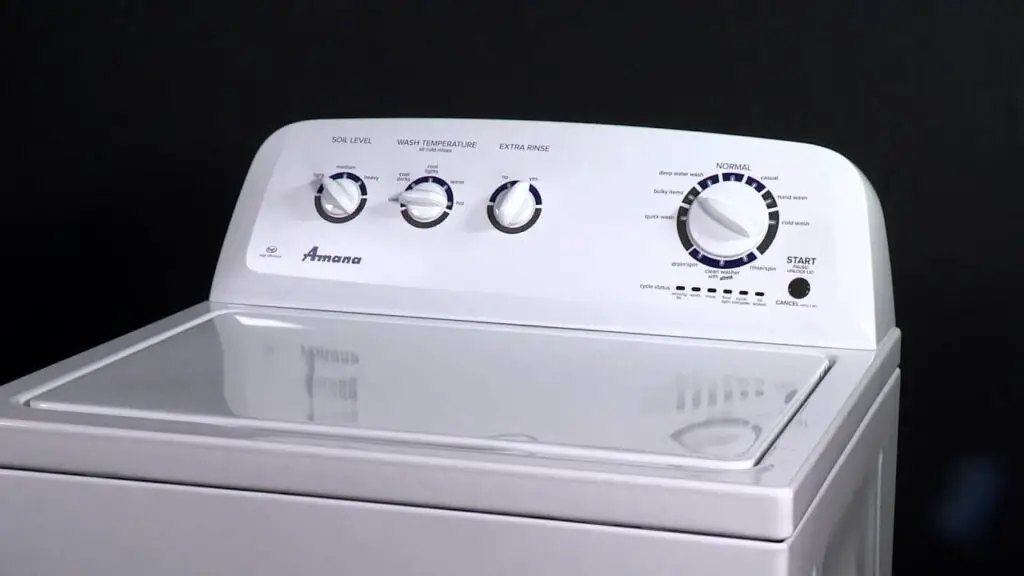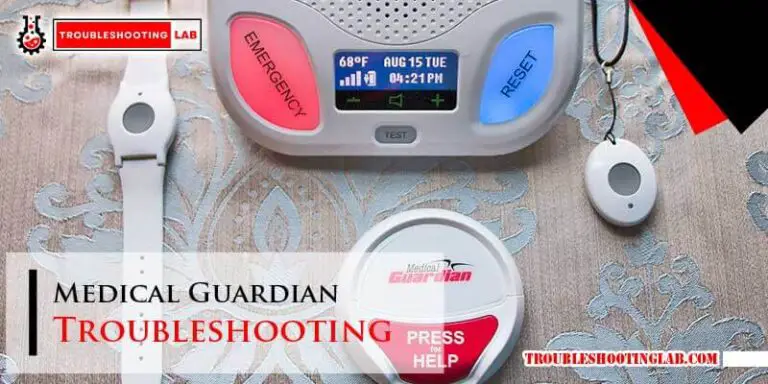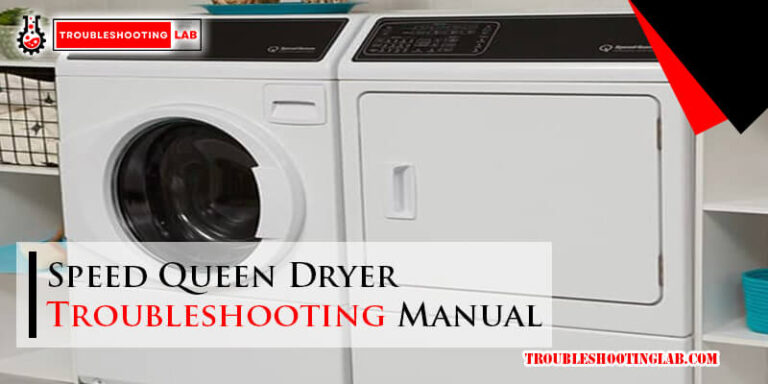Amana Top Load Washer Troubleshooting: Best Solutions
To troubleshoot Amana top load washers, check for worn-out drive belts, defective lid switches (for top loaders), and faulty door locks (for front loaders). Additionally, make sure all hoses are properly connected, the door seals are clean, and the drain hose is clear.

Understanding The Common Issues With Amana Top Load Washers
Overcoming Noise Problems During The Wash Cycle
One common issue with Amana top-load washers is noise during the wash cycle. If you notice that your washer is making unusual sounds while it is running, there are a few troubleshooting steps you can take to address this problem.
- Check for any loose items in the drum that may be causing the noise. Remove any coins, buttons, or other small objects that may have gotten caught in the washer.
- Inspect the washer’s suspension rods to ensure they are intact and in good condition. If the rods are damaged or broken, they may need to be replaced.
- Verify that the washer is level and stable. Use a level to check if the washer is balanced properly. If it is not level, adjust the washer’s feet until it is stable.
- Inspect the drive belt for any signs of wear or damage. A worn-out drive belt can cause the washer to make loud noises during operation. If the belt appears worn, it may need to be replaced.
- Clean the washer’s water inlet valve screens. Over time, debris and mineral deposits can accumulate on the screens, causing the washer to make noise. Remove the screens and clean them thoroughly.
By following these troubleshooting steps, you can overcome noise problems during the wash cycle and ensure that your Amana top-load washer operates quietly and efficiently.
Addressing A Bouncing Or Shaking Washer
Another common issue with Amana top load washers is
bouncing or shaking motions during operation. If your washer is vibrating excessively or moving around, there are a few steps you can take to address this problem.
- Check that the washer’s feet are properly adjusted and leveled. Adjust the feet until the washer is stable and does not wobble or move during operation.
- Ensure that the washer is loaded evenly. An unbalanced load can cause the washer to bounce or shake. Distribute the clothes evenly in the drum to prevent this issue.
- Inspect the suspension springs to make sure they are intact. If the springs are damaged or broken, they may need to be replaced to prevent excessive movement during operation.
- Check for any loose or damaged components in the washer’s motor or drum. Tighten any loose screws or bolts, and repair any damaged parts as needed.
- If the issue persists, consider reducing the load size. Overloading the washer can cause it to shake or bounce. Follow the manufacturer’s recommendations for load size to prevent this problem.
By following these troubleshooting steps, you can address a bouncing or shaking washer and ensure smooth and stable operation of your Amana top load washer.
Dealing With A Non-spinning Washer
If your Amana top load washer is not spinning, there are several potential causes that you can troubleshoot to resolve the issue.
- Check if the lid switch is functioning properly. The lid switch ensures that the washer does not spin when the lid is open. If the switch is defective, it may need to be replaced.
- Inspect the drive belt for any signs of wear or damage. A worn-out drive belt can prevent the washer from spinning. If the belt appears worn, it may need to be replaced.
- Verify that the washer is not overloaded. Overloading the washer can cause it to not spin. Remove some items from the load and redistribute them evenly.
- Check for any obstructions in the washer’s drain pump. A clogged drain pump can prevent the washer from spinning. Clear any debris or foreign objects from the pump.
- Ensure that the washer is level and stable. Use a level to check if the washer is balanced properly. If it is not level, adjust the washer’s feet until it is stable.
By troubleshooting these potential causes, you can address a non-spinning washer and restore the proper functionality of your Amana top load washer.
Troubleshooting Water Leakage Issues
If you are experiencing water leakage issues with your Amana top load washer, there are a few troubleshooting steps you can take to identify and resolve the problem.
- Check if the water inlet hoses are properly connected and tightened. Loose or damaged hoses can cause water to leak from the washer.
- Inspect the water inlet valve for any leaks or damage. If the valve is defective, it may need to be replaced.
- Ensure that the washer’s drain hose is securely connected and not clogged. A clogged or improperly connected drain hose can cause water to leak from the washer.
- Check for any signs of damage or wear on the washer’s tub seal or door gasket. If these components are damaged, they may need to be replaced to prevent water leakage.
- Verify that the washer is level and stable. A tilted or unbalanced washer can cause water to leak during operation. Adjust the washer’s feet until it is level.
By following these troubleshooting steps, you can effectively address water leakage issues and ensure the leak-free operation of your Amana top load washer.
Resolving Noise Problems During The Wash Cycle
Checking For Loose Objects Inside The Drum
If you’re experiencing unusual noise during the wash cycle of your Amana top-load washer, it’s essential to check for any loose objects that may have found their way into the drum. These objects can cause a significant disturbance and result in unpleasant noise. To do this, follow these simple steps:
- Turn off and unplug the washer to ensure safety.
- Open the washer lid and carefully inspect the drum for any objects like coins, buttons, or small pieces of clothing.
- If you find any loose objects, remove them gently to prevent damage to the washer or clothing.
- Close the lid securely and plug the washer back in before restarting the wash cycle.
By regularly checking for loose objects inside the drum, you can prevent unnecessary noise and ensure a smooth and quiet wash cycle.
Inspecting And Tightening The Drum Pulley
In some cases, a loose or faulty drum pulley can contribute to noise during the wash cycle. It is crucial to inspect and tighten the drum pulley to ensure optimal performance. Here’s how:
- Turn off and unplug the washer for safety.
- Locate the drum pulley beneath the washer.
- Using a wrench or pliers, carefully tighten the bolt securing the pulley to the drum.
- Ensure the pulley is securely fastened and does not wiggle or move.
- Plug the washer back in and start the wash cycle to check if the noise issue has been resolved.
Taking the time to inspect and tighten the drum pulley can significantly improve the wash cycle noise and ensure the smooth operation of your Amana top load washer.
Replacing Worn-out Belt Components
If your Amana top load washer continues to make noise during the wash cycle, worn-out belt components might be the culprit. Over time, belts can become stretched or damaged, resulting in excessive noise. Follow these steps to replace worn-out belt components:
- Turn off and unplug the washer.
- Locate the belt underneath the washer.
- Inspect the belt for any signs of wear, such as cracks or fraying.
- If the belt appears worn out, order a replacement belt specific to your Amana washer model.
- Follow the manufacturer’s instructions to remove the old belt and install the new one.
- Plug the washer back in, and run a test wash cycle to ensure the noise issue has been resolved.
By replacing worn-out belt components, you can eliminate noise problems and restore the quiet operation of your Amana top load washer.
Lubricating The Bearings And Motor
Insufficient lubrication of the bearings and motor can often cause noise during the wash cycle. Proper lubrication ensures smooth movement and reduces friction, resulting in a quieter operation. To lubricate the bearings and motor of your Amana top load washer, follow these steps:
- Turn off and unplug the washer.
- Locate the bearings and motor, which may require accessing different parts of the washer depending on the model.
- Carefully apply a small amount of lubricating oil or grease to the bearings and motor.
- Ensure the lubrication is evenly applied and covers all necessary areas.
- Plug the washer back in and run a test wash cycle to check if the noise problem has been resolved.
Regular lubrication of the bearings and the motor will help maintain optimal performance and minimize noise during the wash cycle of your Amana top-load washer.
Fixing A Bouncing Or Shaking Amana Washer
If your Amana top-load washer is bouncing or shaking excessively during the wash cycle, it can be both frustrating and potentially damaging to your appliance. Luckily, there are a few troubleshooting steps you can take to address this issue and get your machine back to a smooth and steady operation.
Assessing The Levelness Of The Washer
The first step in fixing a bouncing or shaking Amana washer is to assess the level of the machine. A washer that is not level can easily become unbalanced during the wash cycle, leading to excessive movement and noise. To check the levelness of your washer, follow these steps:
- Ensure the washer is empty and unplugged.
- Place a level on top of the washer, from front to back and side to side.
- If the washer is not level, adjust the leveling legs accordingly to achieve perfect levelness.
- Recheck the levelness using the level.
Once your Amana washer is properly leveled, it should help reduce the bouncing and shaking issues.
Replacing Worn-out Suspension Rods
Another common cause of bouncing or shaking the Amana washer is worn-out suspension rods. These rods help to stabilize the drum and prevent excessive movement during the wash cycle. Over time, the suspension rods can wear out or become damaged, leading to an unbalanced washer. To replace the suspension rods, follow these steps:
- Unplug the washer and remove any clothing or items inside.
- Locate the suspension rods, usually located near the top corners of the washer drum.
- Using a wrench or pliers, carefully remove the old suspension rods from their brackets.
- Install the new suspension rods into the brackets, making sure they are securely fastened.
- Plug the washer back in and run a test cycle to ensure the bouncing or shaking issue is resolved.
Adjusting The Leveling Legs
If your Amana washer is still bouncing or shaking after assessing the levelness and replacing the suspension rods, it may be necessary to adjust the leveling legs. The leveling legs help to ensure the washer is stable on the floor and can help reduce movement during the wash cycle.
- Ensure the washer is empty and unplugged.
- Using a wrench, loosen the lock nut on each leveling leg.
- Adjust the leveling legs up or down to achieve the desired stability.
- Tighten the lock nuts on each leg to secure the adjustment.
- Plug the washer back in and run a test cycle to check if the bouncing or shaking has improved.
By following these troubleshooting steps, you can address the bouncing or shaking issues with your Amana top load washer. Remember to always prioritize safety by unplugging the appliance before making any adjustments or repairs. If the problem persists, it may be best to consult a professional appliance repair technician.
Troubleshooting A Non-spinning Amana Washer
Is your Amana top load washer not spinning? This can be a frustrating issue, but luckily, there are a few common causes that you can easily troubleshoot. In this section, we’ll walk you through checking for a defective lid switch, inspecting and replacing the drive belt, testing the door lock mechanism, and cleaning the drain pump filter. By following these troubleshooting steps, you can get your Amana washer back up and running smoothly.
Checking For A Defective Lid Switch
The lid switch is a safety feature that prevents the washer from spinning if the lid is open. If the lid switch is defective or not functioning properly, it can cause the washer to not spin. To check for a defective lid switch, follow these steps:
- Unplug the washer from the power source.
- Locate the lid switch, which is usually located under the lid or on the side of the washer.
- Inspect the lid switch for any visible damage or loose connections.
- If the lid switch appears damaged or the connections are loose, you may need to replace the lid switch.
- Refer to the manufacturer’s instructions or consult a professional for guidance on replacing the lid switch.
Inspecting And Replacing The Drive Belt
The drive belt is responsible for spinning the washer drum. Over time, the drive belt can wear out or become loose, resulting in the washer not spinning. To inspect and replace the drive belt, follow these steps:
- Unplug the washer from the power source.
- Access the drive belt by removing the back panel or the front panel of the washer.
- Inspect the drive belt for any signs of wear or damage.
- If the drive belt appears worn or damaged, it will need to be replaced.
- Refer to the manufacturer’s instructions or consult a professional for guidance on replacing the drive belt.
Testing The Door Lock Mechanism
In a front-load washer, a defective door lock mechanism can prevent the washer from spinning. To test the door lock mechanism, follow these steps:
- Unplug the washer from the power source.
- Locate the door lock mechanism, which is usually located near the door latch.
- Manually test the door lock by gently pulling on the door.
- If the door lock does not engage or disengage properly, it may need to be replaced.
- Refer to the manufacturer’s instructions or consult a professional for guidance on replacing the door lock mechanism.
Cleaning The Drain Pump Filter
A clogged drain pump filter can cause the washer to not spin. To clean the drain pump filter, follow these steps:
- Unplug the washer from the power source.
- Locate the drain pump filter, which is usually located at the front or bottom of the washer.
- Use a screwdriver or a coin to remove the filter cover.
- Inspect the drain pump filter for any debris or blockages.
- Carefully remove any debris and rinse the filter with water.
- Replace the drain pump filter and securely tighten the filter cover.
By checking for a defective lid switch, inspecting and replacing the drive belt, testing the door lock mechanism, and cleaning the drain pump filter, you can troubleshoot and resolve the non-spinning issue with your Amana top load washer. If the problem persists, it is recommended to consult a professional for further assistance.
Addressing Water Leakage Issues
Water leakage is a common problem that can occur with Amana top-load washers. If left unaddressed, it can lead to damage to your floors and potential malfunctions in your appliance. In this section, we will discuss some troubleshooting steps to help you identify and resolve water leakage issues in your Amana top-load washer.
Inspecting And Tightening The Hose Connections
One of the main causes of water leakage in a top-load washer is loose or improperly connected hoses. To address this issue, you should start by inspecting all the hose connections in your Amana washer. Ensure that the inlet and outlet hoses are tightly secured to both the water faucets and the washer itself. If you notice any loose connections, use a wrench to tighten them.
Replacing Faulty Water Inlet Valves
Water inlet valves control the flow of water into your Amana washer. If you suspect that the leakage is originating from these valves, you may need to replace them. Before proceeding with this step, make sure to turn off the water supply and disconnect the hoses. Consult your Amana washer’s user manual or contact a professional technician for guidance on replacing the faulty water inlet valves.
Checking And Repairing Damaged Hoses
Damaged hoses can cause water leakage in your top-load washer. Inspect all the hoses for any signs of cracks, tears, or bulges. If you find any damage, promptly replace them to prevent further leaks. Additionally, make sure that the hoses are not bent, kinked, or pinched, as these can also lead to water leakage.
Cleaning The Tub And Door Seals
Over time, debris, detergent residue, and mold can accumulate in the tub and door seals of your Amana washer, leading to water leakage. Regular cleaning of these areas is essential to maintain a proper seal and prevent leaks. Use a mild detergent and warm water to clean the tub and door seals thoroughly. Make sure to dry them completely before using the washer again.
By following these troubleshooting steps, you can effectively address water leakage issues in your Amana top-load washer. Remember to always prioritize safety and consult a professional if you’re unsure about any repairs or replacements. Taking proper care of your washer will not only prevent water leaks but also extend the lifespan of your appliance.
Frequently Asked Questions
How Do You Reset An Amana Washing Machine?
To reset an Amana washing machine, follow these steps: 1. Unplug the machine from the power source for at least 1 minute. 2. Plug it back in. 3. Press and hold the “Cancel” or “Power” button for 10 seconds. 4. Release the button. 5. Your Amana washing machine should now be reset and ready to use.
Why won’t My Amana Washer Complete The Spin Cycle?
The most common reason your Amana washer won’t complete the spin cycle is a worn-out drive belt. If it’s a top-loader, a defective lid switch may be the issue. For front-loaders, a faulty door lock can cause the problem. Check these components for any defects.
How Do I Reset The Lid Lock On My Amana Washer?
To reset the lid lock on your Amana washer, follow these steps: 1. Unplug the washer from the power source for one minute. 2. After one minute, plug the washer back in. 3. Close the lid and wait for at least a minute to see if the lid lock resets. 4. If the lid lock doesn’t reset, try repeating the steps or consult the product manual for further instructions.
How Do I Calibrate My Amana Top Load Washer?
To calibrate your Amana top load washer, follow these steps: 1. Ensure all hoses are connected properly. 2. Clean and check the door seals for any damage. 3. Clear any blockages in the drain hose. 4. Verify that the water pressure at the faucet is sufficient. 5. Check the screen filter in the connector for any debris.
How Do I Troubleshoot A Leaking Amana Top Load Washer?
To troubleshoot a leaking Amana top load washer, check the water inlet hoses for any leaks or damage. Also, inspect the tub seal and drain pump for any leaks.
Conclusion
If you’re experiencing issues with your Amana top-load washer, don’t worry! This troubleshooting guide has provided you with all the necessary information to identify and fix common problems. From how to reset the machine to replacing worn-out drive belts, we’ve covered it all.
Remember to check hoses, seals, and drain filters regularly to prevent further issues. By following these simple steps, you’ll ensure your washer works efficiently for years to come. Happy washing!




